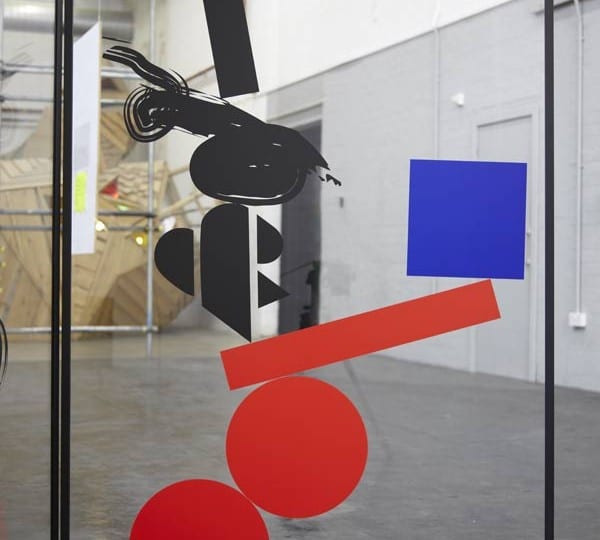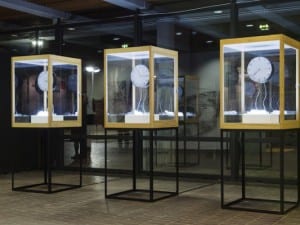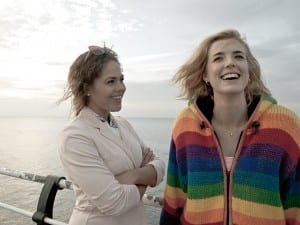At a time when the city of Birmingham seems to be growing to become a viable source of fantastically cutting edge contemporary art, the latest exhibitions to populate Eastside Projects prove to be an example to the rest of the country as to just what Birmingham has to offer. Abstract Possible revisits a quintessential 20th century artistic movement that was also to produce the backbone to many more subsequent movements, but has since taken intriguing routes in the 21st century. Artists have redesigned the process of formal abstraction within a work’s particular aesthetics to now include social abstraction and abstraction as an economic process. This broad range of interpretations of “abstract” is majestically displayed within the seductive confines of the main gallery. This space has had a superficial makeover transforming it into an enchantingly glossy minimal paradise that can’t help but penetrate deep in to the depths of one’s psyche raising and addressing topical issues with a subtle fluidity.
The gloss black floor, a work by Wade Guyton – untitled (2010) acts like a dreamlike yet gothic lake reflecting and tracing everyone’s movements around the space, holding them prisoner in its impenetrable mystique, is the main alteration to the appearance of the gallery. This in itself could be seen as a perplexing outcome of abstraction, a reduction of detail distorting the mirror image of what exists above to mere expressive shapes of colour and fractured representation. Rising from the depths of this black ocean is an unusual panelled installation, enigmatically capturing the attention of all that inspect for clues as to its cryptic being. José León Cerrillo’s Hotel Eden Revisited (2011) is very much at the forefront of the formal abstraction. It’s concertinaed panels of plexiglass, two-way mirrors and applied light act beautifully as artificial tools for fragmentation, dissection and alienation, creating geometric constructions that are constantly transforming as one circumnavigates the installation trying to unravel it’s guise from every angle through perception. Upon one of the panels is a peculiar set of triangles, squares and circles, in solid blocks of white, blue and red arguably beautifying the crisp darkness of the floor and panel frames and the arctic fog of the pristinely white bare walls. Cautiously, one begins to try and disarm this mystery, desperately trying to focus on it one will always fall clear of a rational answer. There is none, there is no definitive meaning. It could signify a further formal abstraction of the shapes the interjecting panels create and dispel with the viewer’s gaze, or simply be a purely aesthetical afterthought. Whatever the answer it remains completely unnecessary and would only add to distract one away from the sole duty of the work, to formally abstract from within its environment at every angle one cares to look at it. This is a shame as it does fulfill its potential so wonderfully that it becomes a seemingly unusual occurrence within the context of modern art – it is not reliant on a full awareness and understanding of its concept to function properly, a characteristic that some would argue has evolved to become rather dislocating to some audiences.
Circling around the centre installation like orbiting satellites, are various other mediums of abstraction subtly fragmenting any aesthetical traits the works might have in common which only adds to cement the focus on the parallels made evident in their “abstraction.” One such piece is Alejandra Salinas and Aeron Bergman’s video work Abstract Your Shit Is (2009). The video shows abstracted elements of money, shown in extreme close up, a still image of which is reproduced on the billboard on the front of Eastside Projects. It feels almost like a homage to the tongue in cheek provocations caused by the use of the Benday Dot technique used by Lichtenstein in his paintings (that somewhat abstract technique itself, making large pictures with isolated dots of colour as seen in a printing press, focuses upon the individual lines of colour and abstracted from the billboard appears like a geometric finger print.) Perhaps it is trying to personify the digital confines of the television screen, for the sound accompanying films is ridden with angst and hatred. The sound is the voice recording of attorney Kenneth Cockrel in 1969 calling the judge in police corruption case a “lawless rogue bandit, thief, honky dog fool and a racist pirate”, mesmerizingly Kenneth was able to fight and win the contempt of court charges that followed. Summoning great emotions of disgust and praise for humanity, stepping up and staving off evil, the film takes on a great sense of epic.
Goldin+Senneby have used the gallery to present Regus an advert for two closed screenings of the film Looking for Headless (2010), a documentary produced by London-based artists Kate Cooper and Richard John Jones, commissioned by Goldin+Senneby. In contrast to the high ideals of Kenneth Cockrel this works brings one back down to the gritty back stabbing selfishness that humanity has seemed to pollute every sector of society with to some degree. Goldin+Senneby are a captivating duo who have utilized Bataille’s ideas about the act of withdrawal as points of departure to the concrete, the virtual and the undisclosed in association with off-shore financial company Headless Ltd. The term “abstraction” as it is known outside of the art world, and exposes huge ethical violations and illegal trading that seems to lie dormant in most people’s minds. This is communicated through the visual impact of the advertising. It is un-noticeable, un-obtrusive, and removed from direct interpretation making it without a doubt the most powerful and eye opening piece of work in the city. It will barely receive any attention which is rather strange, and abstracted, given the attention that has and will continue to be lavished upon the rest of the work.
Abstract Possible: The Birmingham Beat, 6 October – 1 December, Eastide Projects 86 Heath Mill Lane, Birmingham, B9 4AR.
William Davie
Credits
Photograph by Stuart Whipps, courtesy Eastside Projects




